An Efficient Far-Field Wireless Power Transfer via Field Intensity Shaping Techniques
Abstract
:1. Introduction
- the design of an antenna array to recharge portable devices and small home appliances;
- the introduction of a communication protocol to manage plural energy demands.
2. Receiver Electronic Circuit Design
3. Array Design via Optimized Field Shaping Approach
3.1. Case 1: Single WPT through TR Focusing
3.2. Case 2: Multiple WPT through O-mt-TR Shaping
4. Numerical Assessment in a 3D Environment
5. An Efficient Communication Protocol for WPT
6. Conclusions
Author Contributions
Funding
Conflicts of Interest
References
- Tesla, N. Apparatus for Transmitting Electrical Energy. U.S. Patent 1,119,732, 1 December 1914. [Google Scholar]
- Mai, V.V.; Shin, W.; Ishibashi, K. Wireless Power Transfer for Distributed Estimation in Sensor Networks. IEEE J. Sel. Top. Signal Process. 2017, 11, 549–562. [Google Scholar] [CrossRef] [Green Version]
- He, B.; Yang, N.; Yan, S.; Zhou, X. Regularized Channel Inversion for Simultaneous Confidential Broadcasting and Power Transfer: A Large System Analysis. IEEE J. Sel. Top. Signal Process. 2016, 10, 1404–1416. [Google Scholar] [CrossRef]
- Bi, Y.; Chen, H. Accumulate and Jam: Towards Secure Communication via A Wireless-Powered Full-Duplex Jammer. IEEE J. Sel. Top. Signal Process. 2016, 10, 1538–1550. [Google Scholar] [CrossRef]
- Kurs, A.; Karalis, A.; Moffatt, R.; Joannopoulos, J.; Fisher, P.; Soljačić, M. Wireless power transfer via strongly coupled magnetic resonances. Science 2007, 317, 83–86. [Google Scholar] [CrossRef] [PubMed] [Green Version]
- Hui, S.Y. Planar Wireless Charging Technology for Portable Electronic Products and Qi. Proc. IEEE 2013, 101, 1290–1301. [Google Scholar] [CrossRef] [Green Version]
- Nepa, P.; Buffi, A. Near-Field-Focused Microwave Antennas: Near-field shaping and implementation. IEEE Antennas Propag. Mag. 2017, 59, 42–53. [Google Scholar] [CrossRef]
- Costanzo, A.; Masotti, D. Energizing 5G: Near- and Far-Field Wireless Energy and Data Trantransfer as an Enabling Technology for the 5G IoT. IEEE Microw. Mag. 2017, 18, 125–136. [Google Scholar] [CrossRef]
- Pino, M.R.; Ayestarán, R.G.; Nepa, P.; Manara, G. An Overview on Synthesis Techniques for Near-Field Focused Antennas. In Wireless Energy Transfer Technology; InTech: London, UK, 2019. [Google Scholar]
- Nayeri, P. Focused antenna arrays for wireless power transfer applications. In Proceedings of the 2018 International Applied Computational Electromagnetics Society Symposium (ACES), Denver, CO, USA, 25–29 March 2018; pp. 1–2. [Google Scholar]
- Visser, H.J.; Soussi, M.E.; Hornung, R. Focused Radiative Wireless Power Transfer Experiments. In Proceedings of the 2018 IEEE Wireless Power Transfer Conference (WPTC), Montreal, QC, Canada, 3–7 June 2018; pp. 1–4. [Google Scholar]
- González Ayestarán, R.; León, G.; Pino, M.R.; Nepa, P. Wireless Power Transfer through Simultaneous Near-Field Focusing and Far-Field Synthesis. IEEE Trans. Antennas Propag. 2019, 67, 5623–5633. [Google Scholar] [CrossRef]
- Costanzo, A.; Dionigi, M.; Masotti, D.; Mongiardo, M.; Monti, G.; Tarricone, L.; Sorrentino, R. Electromagnetic Energy Harvesting and Wireless Power Transmission: A Unified Approach. Proc. IEEE 2014, 102, 1692–1711. [Google Scholar] [CrossRef]
- Bellizzi, G.G.; Bevacqua, M.T.; Crocco, L.; Isernia, T. Optimized Multi-Target Time Reversal for 3-D Field Intensity Shaping. IEEE Trans. Antennas Propag. 2018, 66, 4380–4385. [Google Scholar] [CrossRef]
- Fink, M. Time reversal of ultrasonic fields. i. basic principles. IEEE Trans. Ultrason. Ferroelectr. Freq. Control 1992, 39, 555–566. [Google Scholar] [CrossRef]
- Bevacqua, M.T.; Bellizzi, G.G.; Merenda, M. Field Focusing for Energy Harvesting Applications in Smart RFID Tag. In Proceedings of the 2019 IEEE International Conference on RFID-TA, Pisa, Italy, 25–27 September 2019; pp. 263–266. [Google Scholar]
- Della Corte, F.G.; Merenda, M.; Bellizzi, G.G.; Isernia, T.; Carotenuto, R. Temperature Effects on the Efficiency of Dickson Charge Pumps for Radio Frequency Energy Harvesting. IEEE Access 2018, 6, 65729–65736. [Google Scholar] [CrossRef]
- Nintanavongsa, P.; Muncuk, U.; Lewis, D.R.; Chowdhury, K.R. Design Optimization and Implementation for RF Energy Harvesting Circuits. IEEE J. Emerg. Sel. Top. Circuits Syst. 2012, 2, 24–33. [Google Scholar] [CrossRef]
- Merenda, M. Self-adapting Impedance Matching Circuit for UHF RF Energy Harvester. In Proceedings of the Progress in Electromagnetics Research Symposium, Rome, Italy, 17–20 June 2019; pp. 1157–1160. [Google Scholar]
- Felini, C.; Merenda, M.; Corte, F.G.D. Dynamic impedance matching network for RF energy harvesting systems. In Proceedings of the 2014 IEEE RFID Technology and Applications Conference (RFID-TA), Tampere, Finland, 8–9 September 2014; pp. 86–90. [Google Scholar]
- Bucci, O.M.; Isernia, T. Electromagnetic inverse scattering: Retrievable information and measurement strategies. Radio Sci. 1997, 32, 2123–2137. [Google Scholar] [CrossRef]
- Bucci, O.M.; Gennarelli, C.; Savarese, C. Representation of electromagnetic fields over arbitrary surfaces by a finite and non-redundant number of samples. IEEE Trans. Antennas Propag. 1998, 46, 351–359. [Google Scholar] [CrossRef]
- Hsi-Tseng, C.; Tso-Ming, H.; Nan-Nan, W.; Hsi-Hsir, C.; Chia, T.; Nepa, P. Design of a near-field focused reflectarray antenna for 2.4 GHz RFID reader applications. IEEE Trans. Ant. Prop. 2011, 59, 1013–1018. [Google Scholar]
- Fedele, R.; Merenda, M. An IoT System for Social Distancing and Emergency Management in Smart Cities Using Multi-Sensor Data. Algorithms 2020, 13, 254. [Google Scholar] [CrossRef]
- Carotenuto, R.; Merenda, M.; Iero, D.; Corte, F.G.D. An indoor ultrasonic system for autonomous 3D positioning. IEEE Trans. Instrum. Meas. 2019, 68, 2507–2518. [Google Scholar] [CrossRef]
- Merenda, M.; Iero, D.; Carotenuto, R.; Corte, F.G.D. Simple and Low-Cost Photovoltaic Module Emulator. Electronics 2019, 8, 1445. [Google Scholar] [CrossRef] [Green Version]
- Merenda, M.; Iero, D.; Corte, F. Cmos rf transmitters with on-chip antenna for passive RFID and iot nodes. Electronics 2019, 8, 1448. [Google Scholar] [CrossRef] [Green Version]
- Bellizzi, G.G.; Paulides, M.; Drizdal, T.; Van Rhoon, G.; Crocco, L.; Isernia, T. Selecting the Optimal Subset of Antennas in Hyperthermia Treatment Planning. IEEE J. Electromagn. RF Microw. Med. Biol. 2019, 3, 240–246. [Google Scholar] [CrossRef]
- Bellizzi, G.G.; Paulides, M.M.; Drizdal, T.; van Rhoon, G.C.; Crocco, L.; Isernia, T. “Temperature-Inspired” Optimization in Hyperthermia Treatment Planning. In Proceedings of the 13th European Conference Antennas and Propagation (EuCAP), Krakow, Poland, 31 March–5 April 2019; pp. 1–3. [Google Scholar]
- Iliopoulos, I.; Ettorre, M.; Casaletti, M.; Sauleau, R.; Pouliguen, P.; Potier, P. 3D near-field shaping of a focused aperture. In Proceedings of the 2016 10th European Conference on Antennas and Propagation (EuCAP), Davos, Switzerland, 10–15 April 2016. [Google Scholar] [CrossRef]
- Crocco, L.; Di Donato, L.; Iero, D.A.; Isernia, T. An adaptive method to focusing in an unknown scenario. Prog. Electromagn. Res. 2012, 130, 563–579. [Google Scholar] [CrossRef] [Green Version]
- Bellizzi, G.G.; Bevacqua, M.T. The Linear Sampling Method as a Tool for “Blind” Field Intensity Shaping. IEEE Trans. Antennas Propag. 2020, 68, 3154–3162. [Google Scholar] [CrossRef]
- Tavuz, M.E.; Teixeira, F.L. Ultrawideband microwave sensing and imaging using time-reversal techniques: A review. Remote Sens. 2009, 1, 466–495. [Google Scholar]
- Gorji, A.; Zakeri, B. An Improved Time-Reversal-Based Target Localization for Through-Wall Microwave Imaging. J. Electr. Comput. Eng. Innov. (JECEI) 2013, 1, 89–97. [Google Scholar]
- Mukherjee, S.; Udpa, L.; Udpa, S.; Rothwell, E.J.; Deng, Y. A Time Reversal-Based Microwave Imaging System for Detection of Breast Tumors. IEEE Trans. Microw. Theory Tech. 2019, 67, 2062–2075. [Google Scholar] [CrossRef]
- Tortel, H.; Micolau, G.; Saillard, M. Decomposition of the Time Reversal Operator for Electromagnetic Scattering. EEE Trans. Microw. Theory Tech. 1999, 13, 687–719. [Google Scholar] [CrossRef]
- TX91501b POWERCASTER® TRANSMITTER. Available online: https://www.powercastco.com/products/powercaster-transmitter/ (accessed on 10 May 2020).
- Aoudia, F.A.; Gautier, M.; Berder, O. RLMan: An Energy Manager Based on Reinforcement Learning for Energy Harvesting Wireless Sensor Networks. IEEE Trans. Green Commun. Netw. 2018, 2, 408–417. [Google Scholar] [CrossRef] [Green Version]
- Jeong, S.; Lin, T.; Tentzeris, M.M. A Real-Time Range-Adaptive Impedance Matching Utilizing a Machine Learning Strategy Based on Neural Networks for Wireless Power Transfer Systems. IEEE Trans. Microw. Theory Tech. 2019, 67, 5340–5347. [Google Scholar] [CrossRef]
- Bai, T.; Mei, B.; Zhao, L.; Wang, X. Machine Learning-Assisted Wireless Power Transfer Based on Magnetic Resonance. IEEE Access 2019, 7, 109454–109459. [Google Scholar] [CrossRef]
- Morabito, A.F.; Ieracitano, C.; Morabito, F.C. A Machine-learning and Compressive-sensing Inspired Approach to the Optimal Array Pattern Synthesis. In Proceedings of the 2019 PhotonIcs & Electromagnetics Research Symposium—Spring (PIERS-Spring), Rome, Italy, 17–20 June 2019. [Google Scholar] [CrossRef]
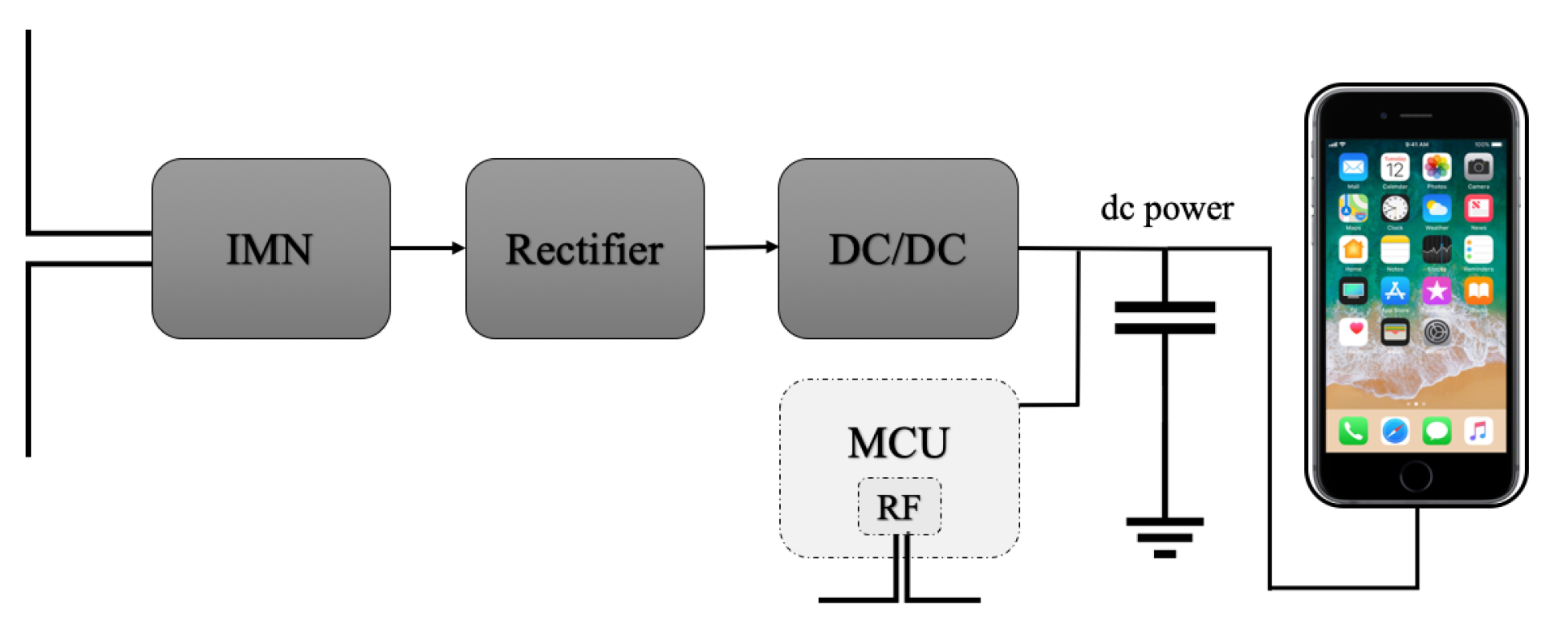

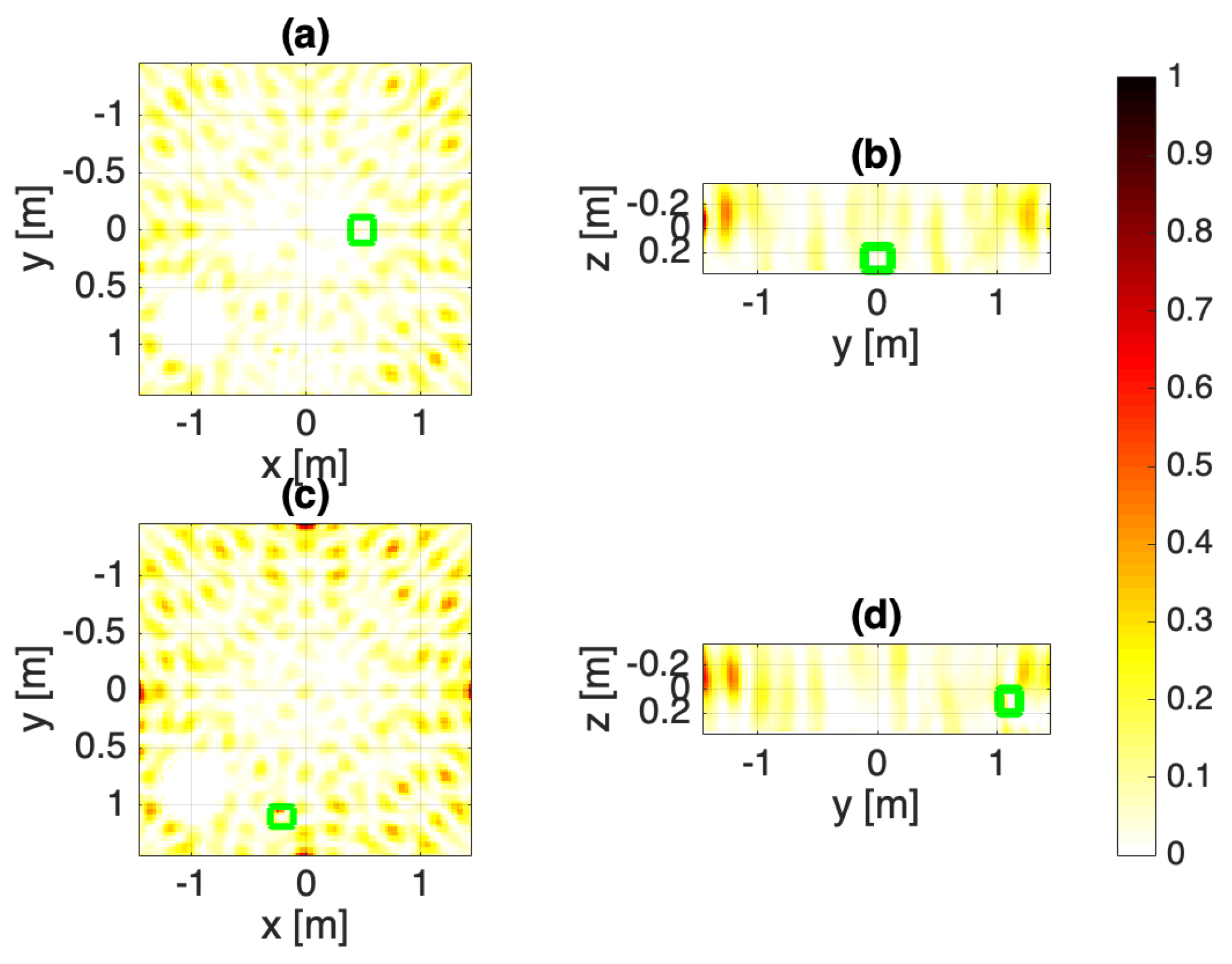

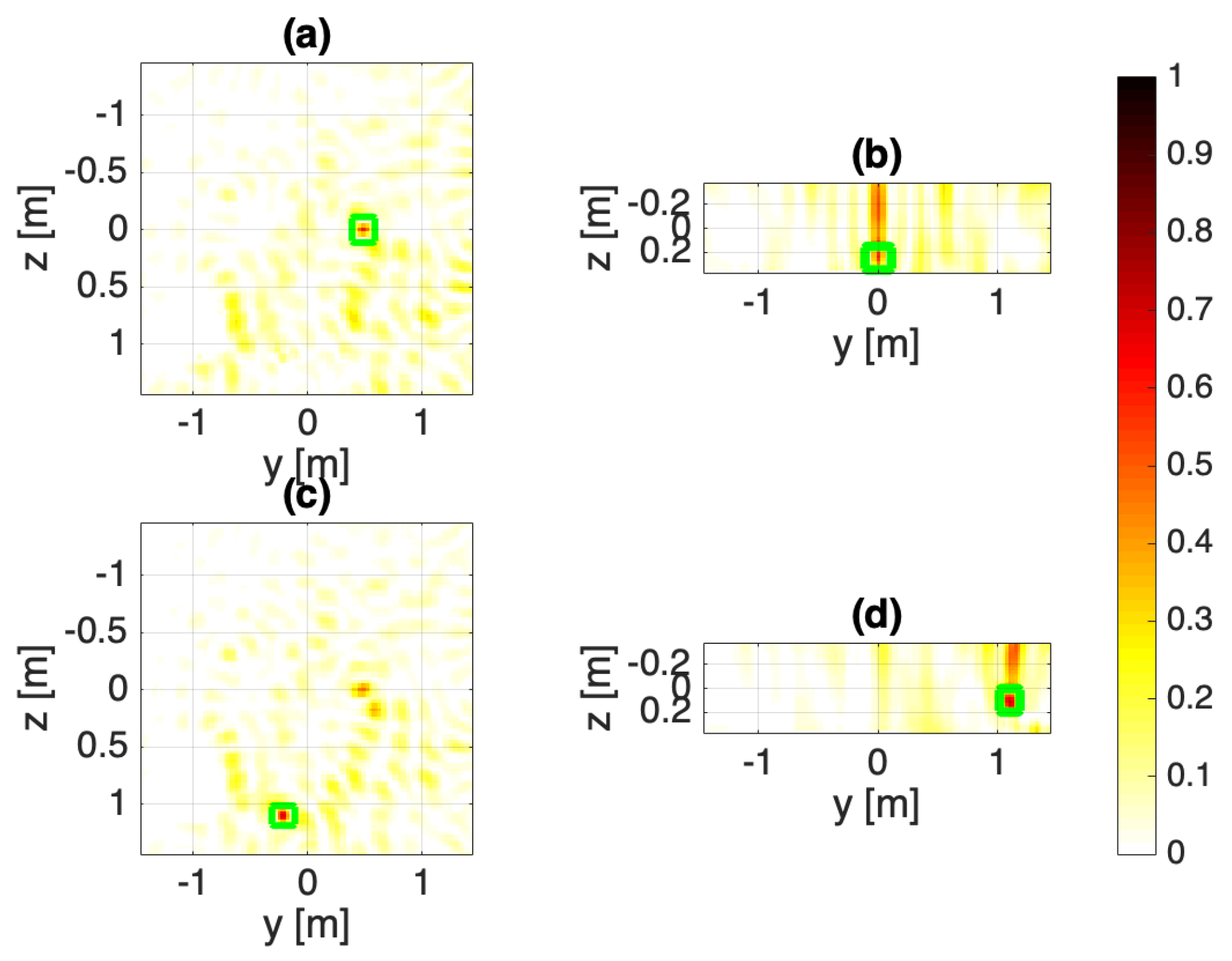
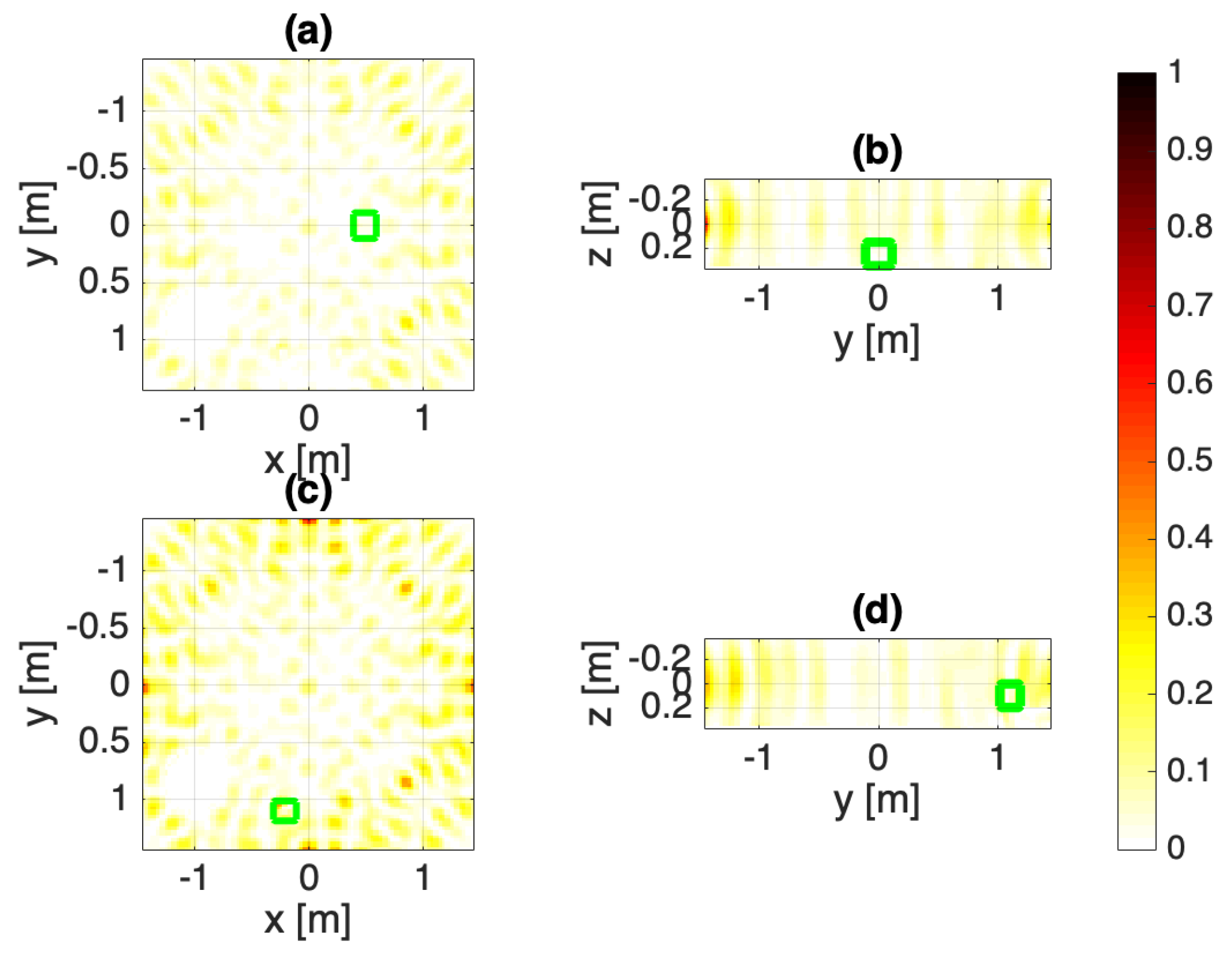

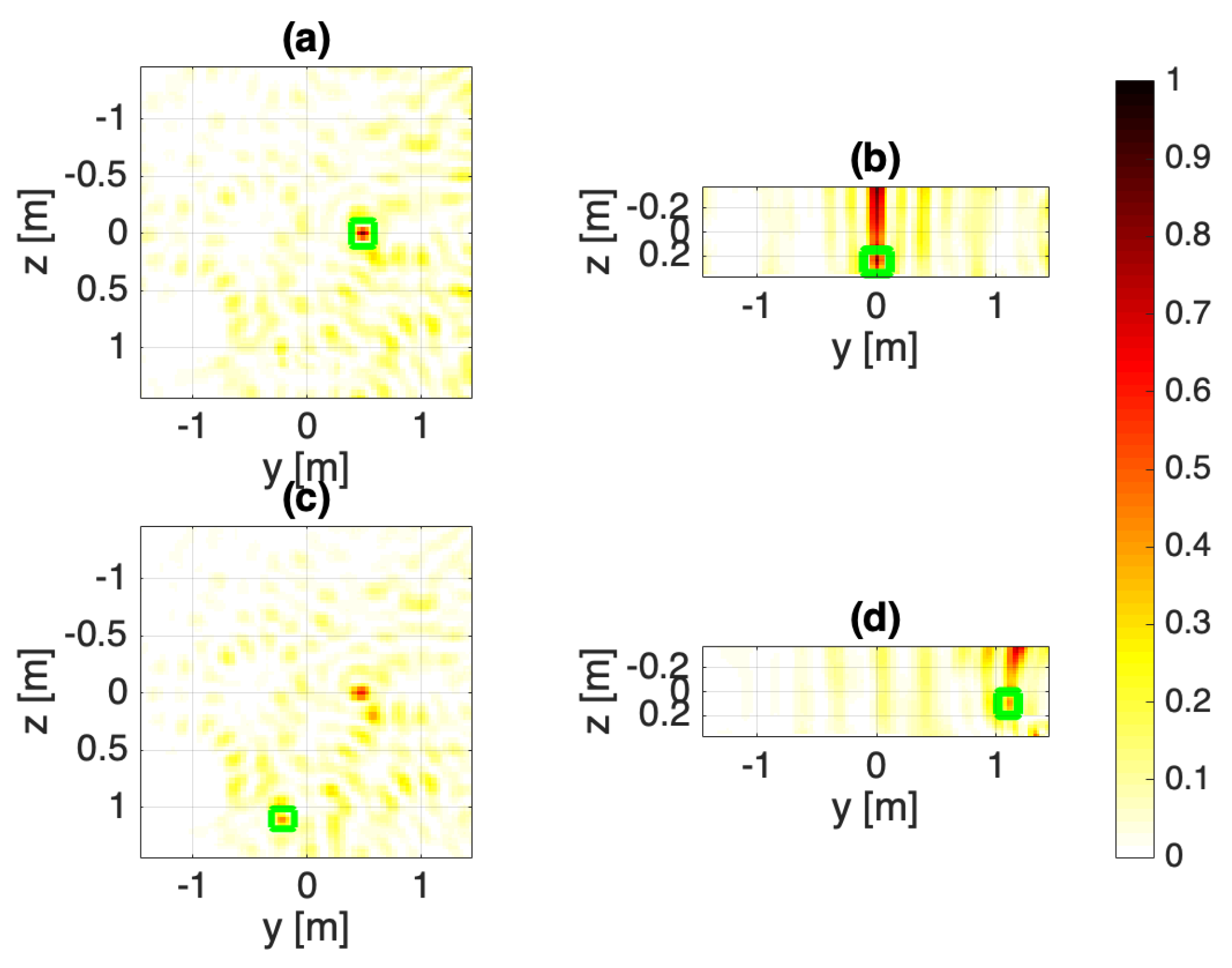
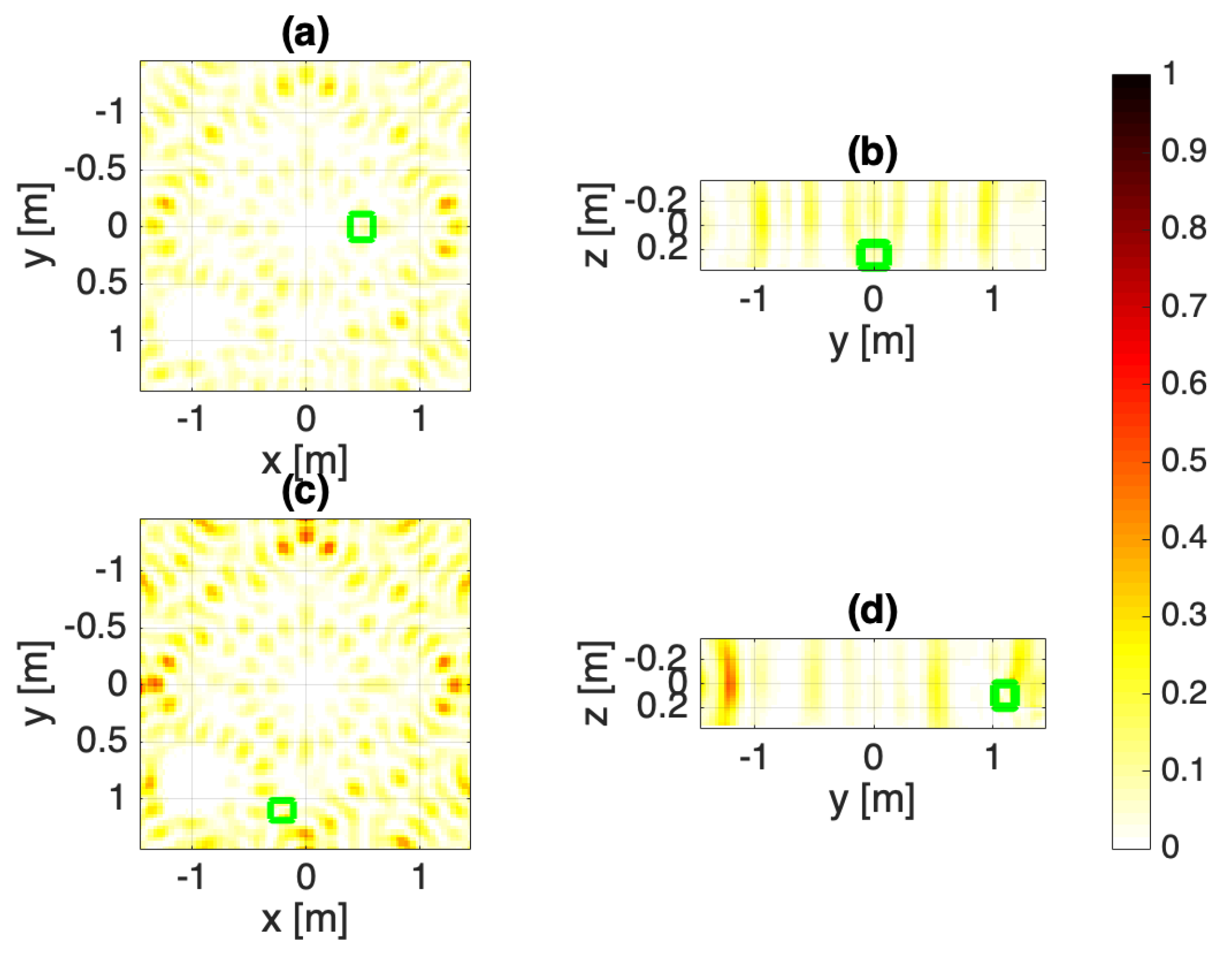


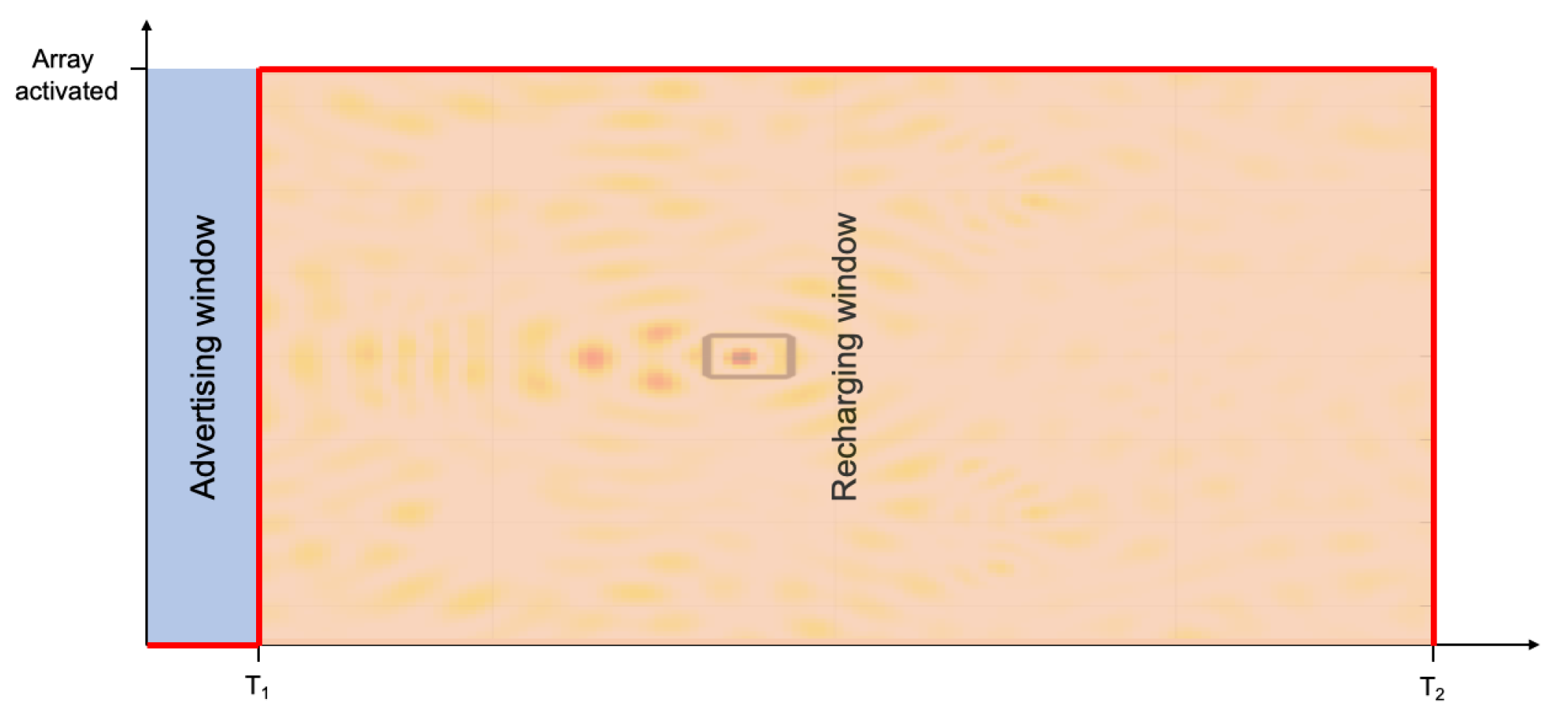
| Target 1 | Target 2 | |||||
|---|---|---|---|---|---|---|
| Configurations | A | B | C | A | B | C |
| Focusing via TR | 87 | 90 | 83 | 99 | 63 | 39 |
| Unitary excitations | 12 | 11 | 21 | 50 | 44 | 39 |
| Shaping via O-mt-TR | 75 | 95 | 91 | 77 | 57 | 24 |
Publisher’s Note: MDPI stays neutral with regard to jurisdictional claims in published maps and institutional affiliations. |
© 2021 by the authors. Licensee MDPI, Basel, Switzerland. This article is an open access article distributed under the terms and conditions of the Creative Commons Attribution (CC BY) license (https://creativecommons.org/licenses/by/4.0/).
Share and Cite
Bevacqua, M.T.; Bellizzi, G.G.; Merenda, M. An Efficient Far-Field Wireless Power Transfer via Field Intensity Shaping Techniques. Electronics 2021, 10, 1609. https://doi.org/10.3390/electronics10141609
Bevacqua MT, Bellizzi GG, Merenda M. An Efficient Far-Field Wireless Power Transfer via Field Intensity Shaping Techniques. Electronics. 2021; 10(14):1609. https://doi.org/10.3390/electronics10141609
Chicago/Turabian StyleBevacqua, Martina T., Gennaro G. Bellizzi, and Massimo Merenda. 2021. "An Efficient Far-Field Wireless Power Transfer via Field Intensity Shaping Techniques" Electronics 10, no. 14: 1609. https://doi.org/10.3390/electronics10141609







